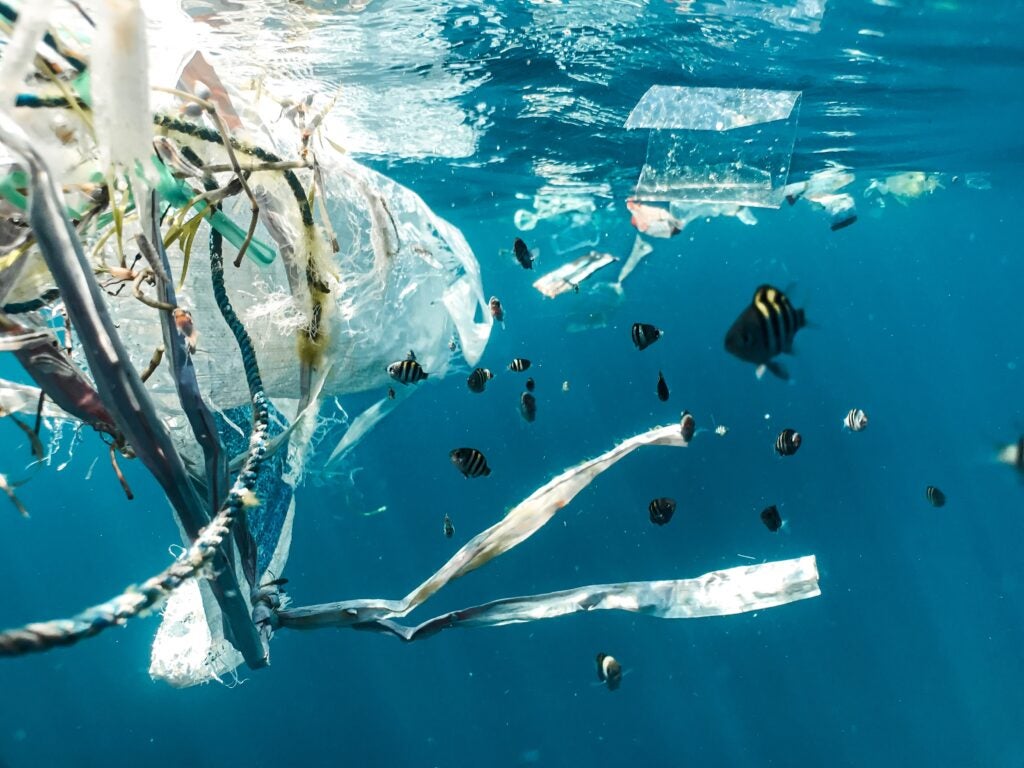Ecosystems Afloat
The ecosystems growing on our plastic waste
By Dr. Rebecca Helm, Ph.D., Assistant Professor, Earth Commons, Georgetown University
What if we told you that there are entire ecosystems on the ocean surface that live on our plastic waste?
When Ben Lecompt swam from California to Hawai’i through the Great Pacific Garbage Patch, he saw something he didn’t expect: life. “Every time I saw plastic debris floating, there was life all around it,” Mr. Lecomte told the New York Times.
As scientists who study high-seas ecosystems, my colleagues and I collaborated with Mr. Lecompt to understand the mysterious ecology of the ocean’s surface. Through our work, we learn that the story of plastic debris in the oceans isn’t as clear as it seems on the surface.

Photo by Naja Bertolt Jensen.
We discovered that floating life might be concentrated by the same physical forces, such as currents and wind, that concentrate plastics. These animals do not depend on plastic and may live peaceably beside our debris. But a key piece of the puzzle is still missing: Mr. Lecompt also found many species living directly on plastic debris.
Why did Mr. Lecompt find a vast amount of life in the Garbage Patch? The answer may lie in an unexpected place: forests.
The story of plastic debris in the oceans isn’t as clear as it seems on the surface.
Before industrial-scale damming and deforestation, large amounts of natural floating wood entered the ocean every year. In fact, there are some species that only live in the open ocean on floating wood. Let me say that again: there are species of animals that have only been found on floating dead trees drifting thousands of miles from shore!
The tragic 2011 Japanese tsunami proved that wood could last years in the open ocean and carry life with it. Animals that call floating debris home are known as rafters, and their natural habitat may be dramatically shrinking. Rafting species are found naturally on driftwood, where they attach themselves and spend years riding on waves.
Now, widespread deforestation and river damming have dramatically decreased the amount of natural wood that enters the ocean. Scientists estimate that, at a minimum, there are 300,000 cubic meters (m3) of large woody pieces entering the ocean each year. In contrast, before humans started altering the environment, at least 70 million m3 of wood objects entered the ocean each year. For rafters, that reduces their living space by over 99%.
If the wood is largely gone, where will the rafting ecosystem go?
Rafting species that can live on buoyant objects are now developing ecosystems on the floating plastics in the ocean. One study found 95 rafting species living on floating plastic in the Great Pacific Garbage Patch.
However, rafting animals are not the only species living around plastic. Floating objects also attract fish.
On a swim through the Garbage Patch, Mr. Lecompt once saw a school of curious fish beneath him. “They were leading me back to what had become their house,” he said of the plastic they now lived around.
The fishing industry has noticed this tendency, too. Tuna fisheries now intentionally release between 47,000–105,000 large floating objects into the ocean every year, many of which are made out of plastic. These objects, called “fish aggregating devices” (or FADs), attract large open-ocean fish, especially tuna. Once enough fish gather around a FAD, a fishing boat surrounds the FAD with a purse-like net to collect the island of life. If you’ve eaten tuna recently, there is a chance you have eaten a fish collected with a FAD.
The tendency of tuna and other open-ocean fish to gather around floating objects hints at what may have been a once-great ecosystem floating at the ocean’s surface. The massive reduction in oceanic wood and the global increase in plastic have undoubtedly changed the open ocean. While plastic may be a far more dangerous material than wood, it is undeniably a home for some animals.
Recently, we have seen a big public push to “save our oceans” by cleaning up plastic in the open ocean using large nets or other remote devices. While images of marine life tangled in plastic are heartbreaking, the rush by some companies to clean up plastic from the open ocean may be premature because we know very little about the impacts of plastic in the open ocean, and even less about the ecosystems now growing on our waste.
While plastic may be a far more dangerous material than wood, it is undeniably a home for some animals.
Though little is known, we cannot ignore the role the rafting ecosystem, now displaced onto plastic, may play in the health of our oceans. We cannot disregard the unknown historical damage that logging and damming may have inflicted upon the ocean’s surface.
As scientists and citizens, we must address the negative impacts of plastic, but we can and should also examine the role that plastic may play in keeping the rafting ecosystem afloat. After all, deforestation and damming will certainly not stop anytime soon, and the amount of floating plastic debris entering the ocean will inevitably continue to grow. We must understand the role of the rafting ecosystem and floating debris in our ocean health in order to protect the ocean’s future.
